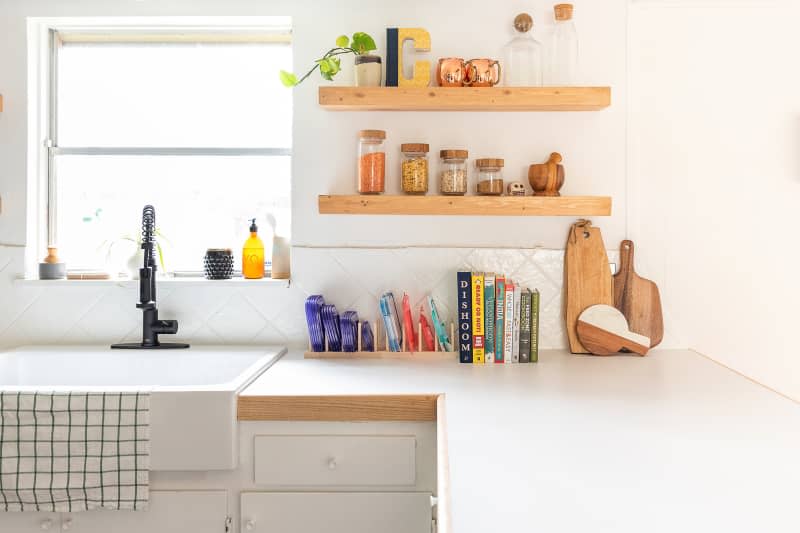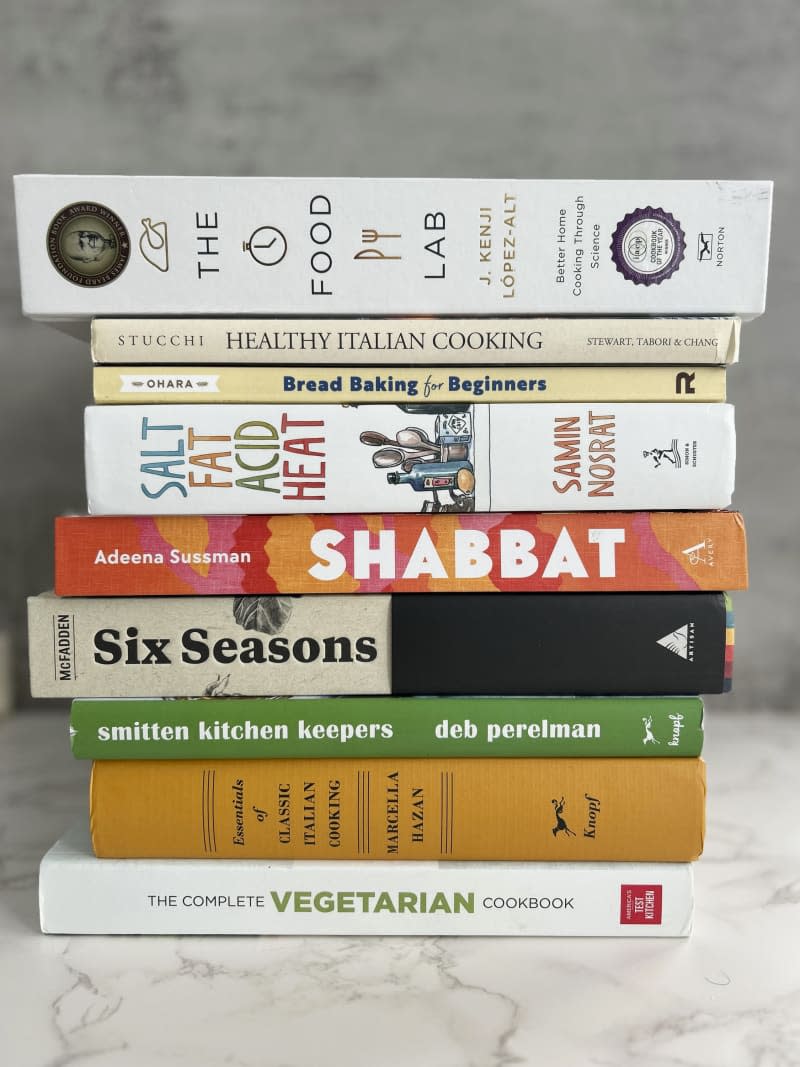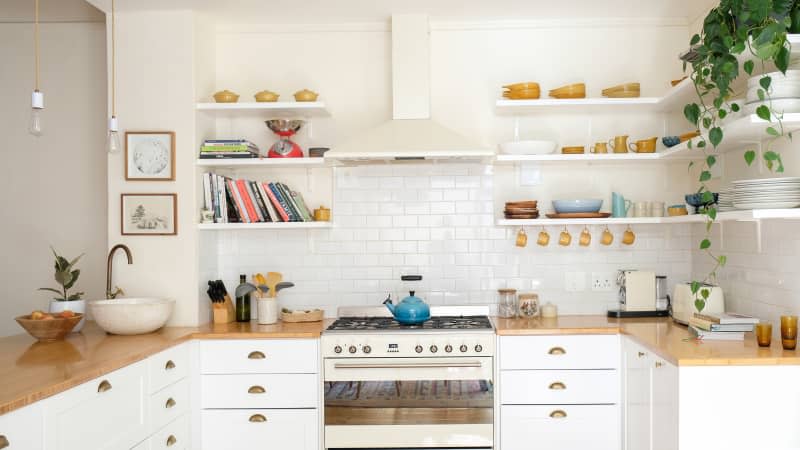The One Kitchen Staple I Always Buy Used

Every month, a group of friends and I get together for our cookbook club dinner. The premise is simple: We pick a cookbook, select a menu, and sign up to make the recipes. Throw in a budget-friendly tablescape, some Trader Joe’s floral centerpieces, and ambient music, and the planning culminates in a potluck-style party.
At the heart of each gathering is a featured cookbook inspired by the season or the ingenious nature of a beloved culinary icon (think: Ina Garten). It didn’t take very long to rotate through the bulk of the cookbooks we own, and as we did, I came to rediscover their timeless allure and practical value. However, like most collectibles, they don’t necessarily come cheap — a single book can set you back $30, $40, even $50. Now, I’m slowly curating my cookbook collection in a more budget-friendly (and environmentally sustainable) way: I’m thrifting them.
Prior to cookbook club, I doubted the utility of cookbooks. Sure, they made great kitchen counter decor or coffee table reads, but why pay for a limited set of recipes when anything you need is just a Reel or hashtag away? It was only when I began leafing through a copy of Carla Lalli Music’s That Sounds So Good that I developed a keen appreciation for the anecdotal snippets, shopping strategies, and alternative ingredients that cookbooks uniquely offer. Soon enough, I was hungry for more. There’s a reason cookbooks have withstood the test of time. Most recipes are methodically written and tested until perfection, and oftentimes provide suggestions for variations, substitutions, and explanations for why things work.
For those looking to expand their palate, cookbooks offer easy ways to venture out of your culinary comfort zone, guiding your exploration through the nuances of various cuisines (a personal favorite is Yotam Ottolenghi’s Simple). If you’re looking to build your skills, other books are more educational, delving into the science behind culinary tools and techniques (two favorites of mine are The Food Lab, and Salt, Fat, Acid, Heat]. What’s more, there is a unique, tactile quality to cookbooks both new and old that echoes a timelessness no digital recipe can replicate.

And while I do enjoy the crisp and clean pages of a new book, the nostalgia of worn covers and water-warped pages of many secondhand books evokes an authenticity that no digital or fresh-off-the-press print can provide. Rustic illustrations, personal anecdotes, and shorthand notes scribbled in the margins have made these books some of my most cherished culinary companions.
When I resolved to build my cookbook collection, I decided to approach it the same way I purchase all of my other books: secondhand. Thrifting for cookbooks has not only brought lots of wonderful older editions into my life, but it has also let me expand my recipe library on a budget. Here are my favorite places to look for pre-loved cookbooks.
Goodwill and Other Thrift Stores
My local thrift stores are better known for their vintage clothing and kitchenware, so this can be a hit-or-miss stop for cookbooks. However, not all thrift stores are created equal, and some may have a hidden gem or two buried within their bookshelves.
Library Sales
Many public libraries will do an annual “friends of the library sale,” which is a great place to purchase recycled reads, often for just $1, $2, or $3. If you find a vintage one, hold onto it — it may be worth a lot.
Secondhand Bookstores
Don’t sleep on your local used book store. After two years in my neighborhood, I finally ventured into mine and found a brand new America’s Test Kitchen cookbook for half off.
Secondhand Book Websites
Thriftbooks.com and Secondsale.com are just a couple of my go-to websites for pre-owned cookbooks. I’ve saved almost $20 on a single cookbook in pristine condition. These sites often run deals like “buy three, get one free.”
Cookbook Exchange
An idea we’ve tossed around our cookbook club was to do a cookbook exchange, White Elephant-style. You could swap permanently, but oftentimes a temporary loan is a great way to “try before you buy.” Sometimes it’s difficult to justify purchasing an entire cookbook when you think you’ll only enjoy a fraction of the recipes, so exchanging cookbooks with a friend or group of friends is a fantastic, risk-free way to determine if it’s worth committing to.
Barnes and Noble’s Bargain Books Section
I’ve always had an affinity for the B&N bargain books section. In most locations you’re greeted with it as soon as you enter, and the discounts are steep at 50% to sometimes 70% off.

What to Do with All Those Cookbooks
In building your library of cookbooks, you may begin to confront the challenge of where to keep them.
If you’re short on space, floating shelves or plate holders can not only maximize vertical space, but also add a decorative touch to my kitchen area.
For thinner books, picture ledges are a creative way to leave your books on display.
A wicker basket or countertop crate can also keep your collection together.
Stacking your books on a cake stand is an ingenious way to display smaller collections.
Embracing these inventive display ideas will not only bring character to your home, but also functionality. And, once your collection grows too large to recall which book that perfect chocolate chip cookie recipe came from, Eat Your Books provides an easy way to digitally catalog your cookbook collection and search for recipes by filter.
Whether you’re an amateur baker, home cook hobbyist, or just dabbling in the culinary arts for fun, I urge you to reconsider your recipes. While the ability to search and scroll offers undeniable convenience, there is an unmatched magic to opening a cookbook. And buying them secondhand will allow you to infuse new life into them in a way that is sustainable, sentimental, and budget-savvy all at once.

